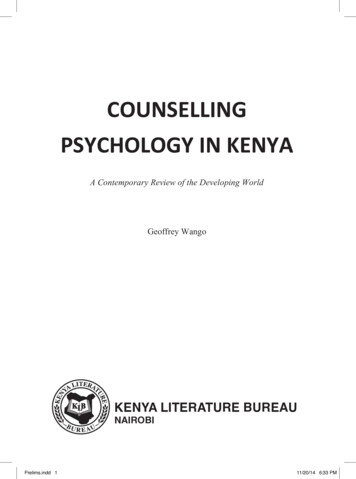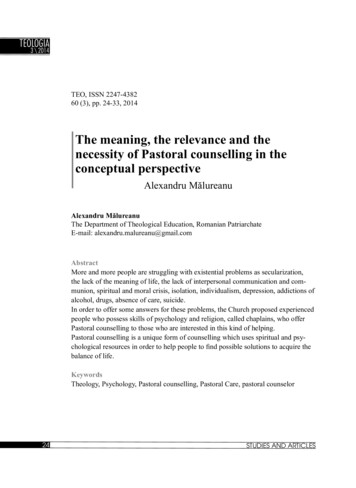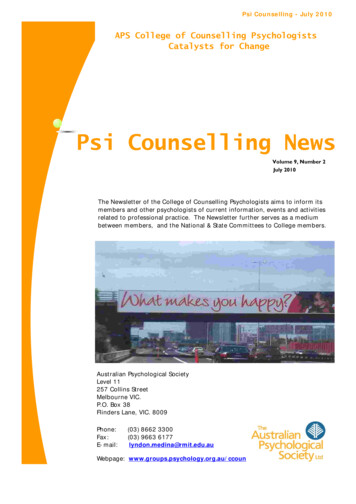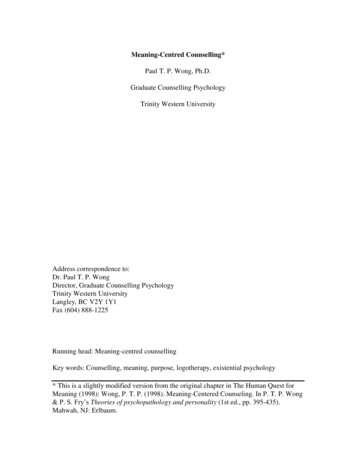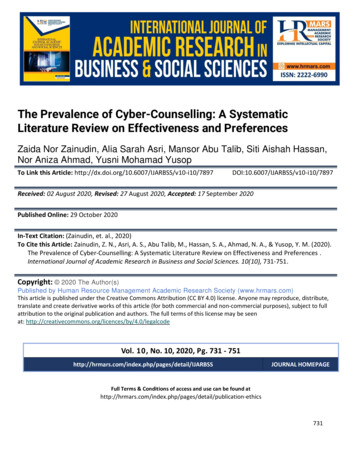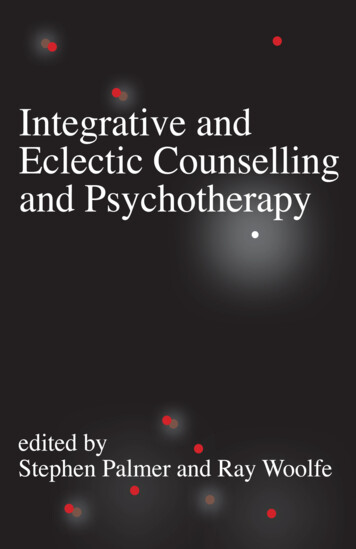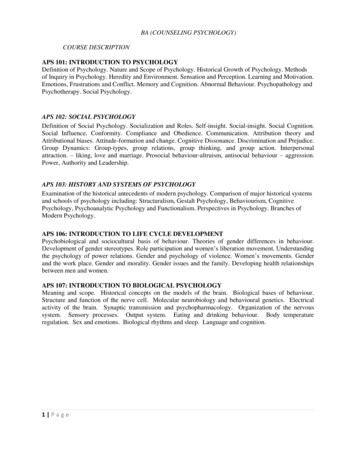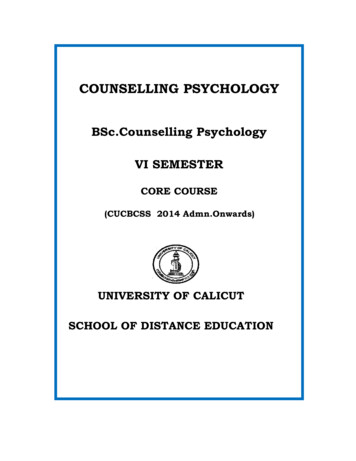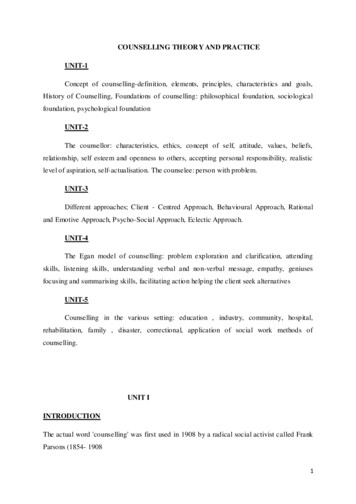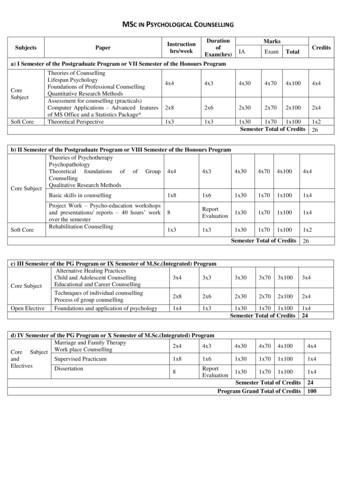
Transcription
MSC IN PSYCHOLOGICAL nofExam(hrs)MarksIAExamTotalCreditsa) I Semester of the Postgraduate Program or VII Semester of the Honours ProgramCoreSubjectSoft CoreTheories of CounsellingLifespan PsychologyFoundations of Professional CounsellingQuantitative Research MethodsAssessment for counselling (practicals)Computer Applications – Advanced featuresof MS Office and a Statistics Package*Theoretical 002x41x31x31x301x701x100Semester Total of Creditsb) II Semester of the Postgraduate Program or VIII Semester of the Honours ProgramTheories of PsychotherapyPsychopathologyTheoretical foundations of of Group 4x44x34x30CounsellingQualitative Research MethodsCore SubjectBasic skills in counselling1x81x61x30Soft CoreProject Work – Psycho-education workshopsand presentations/ reports – 40 hours’ workover the semesterRehabilitation on1x301x701x1001x41x31x31x301x701x1001x2Semester Total of Creditsc) III Semester of the PG Program or IX Semester of M.Sc.(Integrated) ProgramAlternative Healing PracticesChild and Adolescent re SubjectTechniques of individual counselling2x82x6Process of group counsellingOpen ElectiveFoundations and application of psychology1x41x3Supervised 002x41x301x70 1x100Semester Total of Creditsd) IV Semester of the PG Program or X Semester of M.Sc.(Integrated) ProgramMarriage and Family Therapy2x44x3Core Subject Work place 01x4Semester Total of CreditsProgram Grand Total of Credits24100
PAPER 1: THEORIES OF COUNSELLINGObjectives: To provide theoretical foundation for counselling practice.To help the trainee counsellors to choose appropriate techniques for a particular case.Unit 1 - Introduction to Counselling: Meaning and Definition of Guidance, Counselling and Psychotherapy.Background and Overview-Historical Context. What helps Clients: Common Factors and Specific Techniques.Meaning of scientific theory. An overview of theories and techniques10 hoursUnit 2 – Psychodynamic Therapy: Psychoanalytic and Psychodynamic theories (Freud, Jung, Adler &others) Historical Development ,Theoretical Principles and techniques -14 hoursUnit 3 – Behavioural Therapy (Thorndike, Watson, Pavlov, Skinner, Bandura)Historical development.Theoretical Principles. Behaviour Modification Techniques and Procedures (14 hours)Unit 4 - Cognitive Therapy (CT- Beck, REBT – Ellis, CBM- Michenbaum, CAT- Ryle)Theoretical Principles. The Practice of Cognitive Therapy – (14 hours)Unit 5 – Humanistic Approach (Maslow, Rogers)Historical Development, Theoretical Principles. The Practice of Person-Centred Therapy - Skills and Techniques(10 hours)References:Axelson, J. A. (1998). Counselling and development in multicultural society. Pacific Group: Brooks.Corey, Gerald. (2009). Theory and Practice of CounselingandPsychotherapy (8th Edition). Monterey, CA:Brooks/Cole.Ellis A. & Dryden N. (1977).The practice of Rational Emotional Behavior Therapy (Rev. Ed.) New York: SpringerEllis A. &MacLaren C. (1998). Rational Emotional Behavior therapy: A Therapist’s guide. CA: ImpactKazdin. A. E.(2001). Behavior Modification. Belmont: WadsworthKottler, J. A. & Brown R. W. (2000). Introduction to therapeutic Counselling. Australia: Brooks/ ColeKrumboltz. J. D., &Thoresen, C. E. (1976). Counselling methods. New York: Holt Rinehart.Laidlow, T. A. & Malmo C. (1990). Healing: feminist approaches to therapy with women. San Francisco: JosseyBossMeichenbaum.D. (1977). Cognitive Behavior Modification: An integrative approach. New York: PlenumSpeigler, M. D., &Guevremont, D. C. (1998).Contemporary Behavior Therapy. Albany: Brooks/Cole.Walker, L. E. (Ed.) (). Feminist psychotherapies: Integration of therapeutic and feminist systems. N. J: Ablox
Paper 2:Lifespan PsychologyLEARNING OBJECTIVES:Emphasis is on gaining better conceptual understanding of healthy development and better practicalunderstanding of how to help children, adolescents, and adults address the developmentalchallenges they face across the life span. Particular focus placed on understanding our owndevelopmental processes as well as the role of cultural difference and commonality in thedevelopmental process.UNIT 1: INTRODUCTION TO LIFE-SPAN DEVELOPMENT(10 HOURS)Meaning of life-span development; Characteristics of life-span (lifelong, multidimensional,multidirectional, plastic, contextual, etc); Nature of development (biological, cognitive, andsocioemotional); Periods of development and conceptions of age; Significant facts aboutdevelopment (early foundations, follows and pattern, characteristics behaviours, characteristicchallenges and hazards, etc)Issues Related to Lifespan Development: Heredity v/s Environment, Active v/s Passive,Continuous v/s Stage-wise, Stability and ChangeScope of Life span development: Counselling psychologists, School Counsellors, Marriage andFamily Counsellor, Career Counsellors, Drug Counsellors, Rehabilitation Counsellors, ClinicalPsychologists, Psychiatrists, Social Workers, and Child Welfare workersUNIT 2: BIOLOGICAL PROCESSES IN HUMAN DEVELOPMENT(10 HOURS)The Evolutionary Perspective: Natural selection and Evolutionary PsychologyGenetic Foundations: Genetic Process (genes, chromosomes, mitosis, meosis, fertilization, sourcesof variability), Genetic Principles (dominant and recessive genes, sex-linked genes, geneticimprinting, polygenic inheritance)Genetic and Chormosomal AbnormalitiesUNIT 3: PHYSICAL DEVELOPMENT(12 HOURS)Prenatal Development: Course, Prenatal EnvironmentDevelopment in Infancy: Patterns of growth, Height and weight gains, reflexes,Development in Childhood: Patterns of growth, Height and weight gain, Major developmentalmilestonesAdolescence: Puberty, Growth spurt, Patterns of growth, Height and weight gain, Majordevelopmental milestonesEarly Adulthood: Physical appearance, Strength, joints and bones; Cardiovascular system;SexualityMiddle Adulthood: Physical appearance, Strength, joints and bones; Cardiovascular system;Sexuality
Late Adulthood: Physical appearance, Strength, joints and bones; Cardiovascular system; SexualityUNIT 4: COGNITIVE PROCESSES AND DEVELOPMENT(12 HOURS)Infancy and Childhood: Piaget, VygotskyAdolescence: ElkindAdulthood: Postformal DevelopmentAging and cognitive skillsUNIT 5: SOCIO-EMOTIONAL DEVELOPMENT(16 HOURS)Part A: Lifespan Theories:Erikson, Levinson, Bronfenbrenner, FowlerPart B: Attachment, Love and ParentingEmotion: Meaning of emotions, regulation of emotions, emotional competence, Development ofemotionsTemperament: Chess and Thomas classification, Kagan’s behavioural inhibition, Rothbart andBates’ classification,Attachment: Erikson’s Theory, Bowlby, Ainsworth, Attachment in adolescenceLove: Sternberg, Dating and Romantic Relationships, Intimacy Relations, handling breakupsParenting: Parental roles, Fathers as caregivers, Parenting styles and discipline, Parent-child/Parent-adolescent relationships, Working parents, DivorcePART C: Identity and Moral DevelopmentDevelopment of Identity: Marcia’s theoryMoral Development, Contexts of moral development: Kohlberg’s theoryREFERENCESBerk, L. E. (2006).Child Development (7th Ed).Pearson Education.Cavanaugh, J. C (2002).Adult Development and Aging (4th Ed).Wadsworth & Thomson Learning.Hall, E. ( 1992). Adult Development and Aging (2nd Ed). John Wiley & Sons, Inc, New York.Hoyer, W. J. &Roodin, A. (2003).Adult Development and Aging (5th Ed), McGraw –Hill higherEducation, Boston.Hurlock, E. B. ( 2006). Developmental Psychology: A life-span Approach (5th Ed), Tata- McGrawHill, New Delhi.Papalia, Diane. E., Wendkos, S. O. And Dushkin, R. F (2005).Human Development.Tata- McGrawHill, New Delhi.
Santrock, John. W. (2011). Life-span Development (13th Ed), Tata – McGraw Hill, New Delhi.Wenar, C. (1994). Developmental Psychopathology- From infancy through Adolescence (3rd Ed).McGraw –Hill Inc., New YorkPAPER 3: FOUNDATIONS OF PROFESSIONAL COUNSELLINGObjectives: This theory paper aims at introducing the theoretical basis of counselling skills, interviewingtechniques, counselors’ personal and professional issues and growth and ethical and legal issues from a multicultural perspective.Unit 1:a.Introduction: Meaning, Nature, Definition and Scope of counseling; Historical perspectives; Counsellingsettings, Counseling psychology in India – development and current status; Research and Evaluation; Currenttrends.10 hoursUnit 2 Counselling relationship: Qualities of helping relationship. Some theoretical models of counseling - CarlRogers, Truax and Carkhuff, Eagan, Ivey and Cormier, Bremh.,12hoursUnit 3 Counselling process – precounselling issues – interview, assessment [standardized and non standardizedmeasures] setting goals, contracting, informed consent, formulation, conceptualization, referalls, issues erpretation,,termination,reporting.10 hoursUnit 4 Skills in counselling – Attending behaviour, observational skills, skills of active listening, reflective skills,integrative skills, influencing skills, capacity forming skills, eliciting and reflecting skills.10hoursUnit 5 professional issues- training of counsellors, supervision, personal and professionalcharacteristics, ethical issues, legal issues, consultation, professional development, competence, peerrelations, licensing, legislation, counseling in diverse groups10 hoursReference BooksBond,Tim (1997). Standards and Ethics for Counsellors in Action. New Delhi: Sage.Brammer, L., M. & MacDonald, G. (1996). The helping relationship Process and Skills.Boston: Allan & Bacon.Carkhuff. Robert, R., (2000) The Art of Helping in the 21st Century. (8th Ed.) New York: HRD Press.Colin Felthman& Ian Horton.(2000) (Ed.) Handbook of Counselling & psychotherapy. Delhi; SageConnor, M. (1994). Training Counsellor: An integrative model. London: Routledge.Corey, M., S. & Corey, G. (1998).Becoming a helper (3rd Edi.) Pacific Grove CA: Brooks/Cole.Corey, G. (2001) Student video & work book for the art of integrative counselling. Pacific Grove, CA:Brooks/Cole.Corey, G. (2001). Manual for theory and practice of counseling and psychotherapy. (6th ed.). PacificCromier, W., H., &Cromier, L., S. (1991). Interviewing Strategies for helpers: Fundamental skills and cognitivebehaviour. Pacific Grove CA: Brooks/Cole.
Grove, CA: Brooks/Cole.Culley, Sue.(2002). Integrative Counselling Skills in Action.(2 edi). London: Sage.Eagan, G. (2001). The skilled helper: A problem management approach to helping. (7th Edi.) Pacific Grove CA:Brooks/ColeDoyle. Robert, E.(1992) Essential Skills and strategies in helping process. California: Brooks/ColeDryden, W, &Thorne,D. (1991). Training & Supervision for Counselling in action. (Ed) London: Sage.Dryden, W., Horton, I. &Mearns, D. (1995).Issues in Professional Counsellors Training. London: CasscllInskipp, F. (1996).Skills training for counseling. London: Cassell.Ivey () Intentional InterviewingNeukrug, E. (1999). The World of the Counselor: An Introduction to the Counseling Profession. Pacific Grove,CA: Brooks/Cole.Richard Nelson-Jones.(2002). Basic Counselling Skills. London: Sage.Sherilyn, L., Cormier, & Harold Hackney. (1987). The Professional Counsellor: A Process Guide to Helping.Boston: Allyn& Bacon.Sherry Cormier,& Paula Nurius.(2002) Interview and Change Strategies for Helpers.(5th edit). London:Wadsworth Pub Co.Stephen Palmer. (2000). Introduction to Counselling & Psychotherapy. New Delhi: Sage.***PAPER 4: Quantitative research methodsLearning Objectives:Learning objectives: To ground students with sound knowledge about the research process thus enabling them toundertake an empirical study and test the accuracy of the findings. Students would get acquainted with the types ofresearch, designs and the ways and means of analysing the data.Unit 1 - Research Process(12 hours)Definitions of research, science and scientific methods, limitations of scientific research. Steps involved in researchprocess (Formulation of a problem, Literature review, Development of a hypothesis, Research design, Samplingdesign, Research proposal, Collecting data, Data analysis, Report writing/ thesis writing).Research problem-source, selection criteria, defining, statement, delimitationEthical issues for research.UNIT 2- VARIABLES,PROBABILITYAND HYPOTHESIS TESTING(14 HOURS)Variables: IV, DV, control and extraneous variables.Hypothesis- definition, characteristics, types; Hypothesis testing
Concept of Probability, Normal Probability Curve, Characteristics of the Curve,: probabilistic estimation andlimitations (Type I & type II errors).Concept of Statistics: parametric and non-parametric, descriptive, inferential, correlational, tests of significance.Unit 3 Sampling and Data Collection(10 hours)Sampling design: Meaning, probability and non-probability sampling methods and determinants of sample size.Data collection methods: Observation: naturalistic, laboratory, participant and non-participant, structured andunstructured; interview: structured and unstructured, questionnaires: close-ended and open-ended, scales.UNIT 4- RESEARCH DESIGNS(16 HOURS)Part A: Experimental Designs: True Experimental (Between group, within groups, factorial),Part B: Quasi-experimental Designs: (Designs with control group, designs without control group, designs tomeasure developmental changes)Part C: Non-experimental (Observational, survey, correlational) ,Other ways of classifying Research Designs: Designs based on the purpose of the study- Exploratory researchdesigns, Descriptive designs, Explanatory designs, Experimental designs; Designs classified by their intended useInterventions designs, Evaluation designs, Action research designs; Designs indicating the effects of time- Crosssectional research designs, Longitudinal research designsUNIT 5- REPORT WRITING(8 HOURS)General Guidelines, Need for a report, Types of Writing, Purpose of writing, Avoiding plagiarism, Organizinginformation, Report writing in APA format, references in APA formatREFERENCES:Best,J.W. & Kahn, J.V (2005). Research in education. Prentice-Hall of India.(9th ed, EEE)Bordens,K.S. &Abbot,B.B. (2002) Research designs and methods: A process approach. McGraw-Hill(5th ed)Cozby,P.C. (1997) Methods in behavioral research. Mayfield Publishing company.(6th ed)Creswell, J.W. (2007) Qualitative inquiry & research design. Sage publications (2nd ed)Compilation of articles for qualitative researchHeppner,P.P, Wampold,B.E. &Kivilighan,D.M. (2008). Counselingresearch.Brooks-Cole.Kothari,C.R. (2003) Research methodology: Methods and techniques. WishwaPrakashan(2nd ed)McBurney, D.H. (2001) Research methods. Thomson Wadsworth (5th ed)Publication Manual of the AmSOFT CORE:Theoretical Perspective:THEORETICAL PERSPECTIVES OF PSYCHOLOGY
Learning Objective.students would get a historical perspective about the development of psychology as anindependent body of knowledge. The emphasis is on understanding human behaviour from each school’sperspective in respect of human motivation, development and functioning of human personality and the applicationof principles of each school to the development of mankind as well as its therapeutic value.1.Psychoanalytical perspective: History, Sigmund Freud’s approach, Carl Jung, Adler, and otherNeo-freudian approach to motivation, personality, therapy and applications.2.Behaviouristic perspective: Learning- Classical Conditioning (Pavlov) and Operant Conditioning(Skinner); Motivation – Drive and incentive theories (Hull), (Miller and Dollard, Rotter); Personality –Mowrer; therapeutic techniques and applications.3.Humanistic & Existential perspectives:Motivation : Hierarchy of motives (Maslow), ERG Theory (Alderfer), Theory of needs (McClelland);Personality : Personal construct ( Kelly), Self theory of personality( Rogers); Existential approaches; therapies and application.4.Cognitive and Social Perspectives: Motivation: Cognitive balance and dissonance theory (Hieder,Festinger); Personality: Dissonance ( Brehm), Social learning theory (Bandura); therapy and application.5.Indigenous Perspectives: Motivation: Advaita, Buddhist and Jaina perspectives; Personality:Advaita, Upanishads, Buddhist and Jaina perspectives; Therapy (healing techniques), Applications.References:Davis R.S ( 1996). Psychology of Learning and Motivation academic press.Ekman, Paul and Davidson, R.J ( Eds-1994). The nature of emotions, fundamental questions.Delhi,OxfordUniversity press Series in affective science.Hall. C.S. Lindzey G and Campbell J.B ( 1998) theories of personality New York john wiley and sons ( 4thedition)Hergenhahn B.R. and Olson M. H. ( 1998) Theories of personality, Prentice HallHilgard, E. R Bower G.H, Sahakian, H ( 1997) Psychology of learning. Prentice hall of India, revised editionLawrence .A, Pervin and Oliver P John ( 1997) Personality: theory and research new york, John Wiley , 7theditionSahakian( 1976) Introduction to psychology of learning. Chicoga: Rand Mcnally college publishing company.Weiner B ( 1985) Human Motivation, New York: Springer and Verlag.PRACTICALS 1:ASSESSMENTFOR COUNSELLING
I Cognitive Functions1. Raven’s Standard Progressive Matrices2. Bhatia’s Performance Battery3. Draw-a-Man test4. Assessment of intelligence using Seguin Form Board5. BinetKamat test of intelligence6. Attention and concentration7. P.G. I Memory scaleII Aptitude And Interests1. David’s Battery of Differential Abilities – Revised [DBDA-R]2 Comprehensive Interest Schedule [CIS]/ Vocational Interest Schedule(VIS)III. Personality: Self-Report Methods1. Eysenck’s Personality Questionnaire [JEPQ]2. R.B. Cattell’s 16 PF3. Neo Five Factor InventoryIV . Personality: Projective Methods1. Draw-A-Person Test [DAP]2. Thematic Apperception Test [TAT]3. Children’s’ Apperception Test [CAT]V. Disability Screening1. Screening for learning disability using NIMHANS index for SLD2. Social Development – Vineland Social Maturity ScaleVI. Other Measures1. Assertiveness2. Emotional QuotientPRACTICAL 2:Practicals on Computers and StatisticsUsing MS Word to create and edit documents:Opening MS Word, Font, centring, justification, right and left alignment, cut, copy, paste, bold, italics, underline,all caps, small caps, strike through, upper case, lower case, sentence case, title case, subscript, superscript, headingsand levels, running head and header, page numbers and footer, inserting pictures, smart art and shapes, margins,new page, new section, inserting symbols, inserting tables, inserting charts, views (print view, outline view),importing and exporting to MS Excel, printing documents; renaming files in the file explorer, copying and movingfiles to other spaces in the hard drive and other drives.Using MS Excel to create and edit spread sheetsRows and columns, entering data, copying and auto fill of data, formulae, creating charts, formatting cells, creatingtables, views (print view) importing and exporting to MS Word and SPSS, printing spread sheets, renaming files inthe file explorer, copying and moving files to other spaces in the hard drive and other drives.Using MS Power point to create and edit presentationsNew slides, title slide, body slide, two column slides etc, creating backgrounds, inserting pictures, charts, drawingobjects, and smart art; inserting simple animations, inserting slide transitions, outline view and slide sorter view,
merging two presentations, creating handouts, creating .rtf files to export to MS Word, renaming files in the fileexplorer, copying and moving files to other spaces in the hard drive and other drives.Using SPSSData entry and coding, Importing data to SPSS from MS Excel, Calculating Mean, Median and Mode, and,Standard Deviation, Scatter-plot,Pearson’s Product Moment Method, Spearman’s Rank order Method, t-test(independent & paired), ANOVA, MANOVA, Chi-square, Mann Whitney U test, Median test, Wilcoxon test, Signtest, Kruskal-Wallis test, Friedman test,Interpreting the output generated by SPSS, Exporting to MS Word, MSpower point, and creating pdf and html formats.IISEMESTERPAPER 201: THEORIES OF PSYCHOTHERAPY To provide theoretical foundation for the practice of psychotherapy.To help the trainee counsellors to choose specific techniques for a particular case.Unit 1:Introduction to: Principles of Psychotherapy, classical approaches to psychotherapy: psychoanalytical,behaviouristic.Unit 2 – Existential TherapyHistorical Development.Theoretical Principles.The Practice of Existential Therapy.Viktor Frankle’sLogotherapy.Gestalt TherapyHistorical Development.Theoretical Principles. Therapeutic Techniques and ProceduresUnit 3 - Choice Theory and Reality TherapyHistorical Development.Theoretical Principles. Reality Therapy TechniquesUnit 4 - Feminist TherapyHistorical Context in Feminist Therapy.Theoretical Principles of Feminist Theory and Therapy.The Practice ofFeminist Therapy.Post Modern ApproachesDevelopment of Social Constructionism. Theoretical principles and practice of Solution Focused Brief Therapyand Narrative Therapy.Unit 5 - Integrative CounsellingFoundations of Theoretical Diversity and Integration - Historical and Theoretical Trends in Counselling andPsychotherapy Integration - The Practice of Specific Eclectic or Integrative TherapiesAxelson, J. A. (1998). Counselling and development in multicultural society. Pacific Group: Brooks.Corey, Gerald. (2009). Theory and Practice of CounselingandPsychotherapy (8th Edition). Monterey, CA:Brooks/Cole.Ellis A. & Dryden N. (1977).The practice of Rational Emotional Behavior Therapy (Rev. Ed.) New York: SpringerEllis A. &MacLaren C. (1998). Rational Emotional Behavior therapy: A Therapist’s guide. CA: ImpactKazdin. A. E.(2001). Behavior Modification. Belmont: WadsworthKottler, J. A. & Brown R. W. (2000). Introduction to therapeutic Counselling. Australia: Brooks/ Cole
Krumboltz. J. D., &Thoresen, C. E. (1976). Counselling methods. New York: Holt Rinehart.Laidlow, T. A. & Malmo C. (1990). Healing: feminist approaches to therapy with women. San Francisco: JosseyBossMeichenbaum.D. (1977). Cognitive Behavior Modification: An integrative approach. New York: PlenumSpeigler, M. D., &Guevremont, D. C. (1998).Contemporary Behavior Therapy. Albany: Brooks/Cole.Walker, L. E. (Ed.) (). Feminist psychotherapies: Integration of therapeutic and feminist systems. N. J: AbloxPAPER 202: PSYCHOPATHOLOGYLEARNING OBJECTIVE: This paper aims to give a broad idea of the field of clinical psychology and tofamiliarize the student with the psychopathological aspects of human behavior.Unit 1:Introduction. Definition, historical review.Changing attitudes and concepts of mental health andillness.Current views.Models for understanding psychopathology.Psychoanalytical, behavioral, interpersonal andhumanistic. Need for and types of classification of mental disorders. DSM and ICD systems of classification.Unit 2: Anxiety and stress related disorders: Causes, types and clinical features of anxiety disorders. GAD, panic,phobic disorders. Obsessive compulsive disorders.Stress related disorders. Causes, types and clinical features of acute and PTSD.Unit 3.Mood and schizophrenic disorders.Causes, types and clinical features of mood disorders (manic, depressive,bipolar mood disorders).Causes, types and clinical features of schizophrenia, Delusional disorders.Unit 4: Somatoform and dissociative disorders. Causes, types and clinical features of somatisation disorder,hypochondriac disorders.Personality disorders, Causes, types and clinical features of paranoid, schizoid personality, antisocial.Unit 5: Substance abuse - Causes, types and clinical features of alcohol and substance abuse.Brain impairment.Dementia, Amnestic syndromes.Pervasive developmental disorders.Causes, types and clinicalfeatures of mental retardation and Autism.References: Carson, R. C. Pincka, S., & Butcher, I N. (1999). Abnormal Psychology and Modern Life. 11 thed. NewYork: Addison Wesley Longman Inc Comer., R. J. (1999). Abnormal Psychology. New Jersey: W. H. Freeman Co. Davison, G. C. & Neale, J. M. (1998). Abnormal Psychology, 7th ed. New York: John Wiley & Sons.
PAPER 203:Theoritical foundations of group consellingObjective:This paper aims at introducing the basic concepts of Group counselling, stages of group development, skills,techniques and strategies to group process, group guidance, Group counselling, and therapeutic group counsellingprocess from a multi-theoretical and cross-cultural perspective.Unit 1- Introduction12 Hoursa. Definitions of groups; characteristics of groups; goals of groups; and purpose of groups (Jacobs, Masson,&Harvill).b. Types of groups; differences between group guidance, group counselling and group psychotherapy (Jacobs,Masson, &Harvill).c. Ethical and professional issues in group counselling (ASGW 2000), Training of Competent GroupCounsellors (Corey &Yalom).Unit 2- Group Leadership12 Hoursa. Definition of a group leader; professional competence and training of group leaders; personal characteristicsof effective leaders (Corey& Jacobs, Masson, &Harvill).b. Role and functions of group leaders – basic tasks, working in the here-and-now, transference andtransparency (Yalom).c. Co-leadership – advantages and limitations; types of co-leadership (Corey, Jacobs, Masson,&Harvill&Yalom). (14 hours)Unit 3- Stages of the Group Process12 Hoursa. Pre-group issues; Initial Stage – characteristics of this stage, group leader functions and skills; Transitionstage – resistance, conflict, problem members (Corey &Yalom).b. Working stage – productivity, therapeutic factors, leader functions (Corey &Yalom).c. Final Stage – consolidation and termination; Post group issues and evaluation (Corey).Unit 4- Leadership Skills12 Hoursa. Basic Skills – Attending behaviour and observation in groups, basic listening sequence (BLS) in groups,group process skills – linking, leading, pacing, tone setting, focusing, modelling (Corey & Ivey).b. Advanced Skills – positive asset search, eliciting group observation, setting goals, reflecting meaning,eliciting group interpretations, mutual feedback, confronting, reframing, self-disclosure (Corey & Ivey).c. Closing skills – Closing a session; closing a group (Corey & Ivey).Unit 5- Theories and Techniques of Group Counselling12 Hoursa. Psychodrama, TA (Corey), role play, sensitivity training, T group training
(*Note – the hours mentioned are inclusive of presentation, totalling to 64 hours, the remaining hours will be usedfor assignment and test.)References:Corey, G. (2008). Group Counselling. New Delhi:Brooks/Cole.Corey, G. (2004). Theory and practice of group counselling (6th ed.). CA: Broks/ ColeThomson Learning.Corey, G., Corey, M. S., &Callan, P. (2003).Issues and ethics in the helping profession.Pacific Grove, CA: Brooks/ Cole.Corey, M. S., & Corey, G. (2002).Groups: Process and practice (6th ed.). Pacific Grove, CA:Brooks/ Cole.Ivey, A., Pedersen, P. B., & Ivey, M. B. (2001).Intentional group counselling: A microskillsapproach. Belmont, CA: Wadsworth/ Thomson Learning.Jacobs, E. E., Masson, R. L., &Harvill, R. L. (2002).Group Counselling: Strategies and skills(4thed.). Pacific Grove, CA: Brooks/ Cole.Yalom, I. D. (1995). The theory and practice of group psychotherapy (4th ed.). New York, NY:Basic Books.Yalom, I. D. (2005). The theory and practice of group psychotherapy (5th ed.). New York, NY:Basic Books.PAPER 204Qualitative Research MethodsQUALITATIVE RESEARCH METHODSLearning objective: This paper provides students with a critical understanding of qualitative research methods inPsychology. The focus of this paper is also to use qualitative methods in conjunction with quantitative methods andindependently. The hands on experiences will help the students to design qualitative studies and the importance ofqualitative research in Psychology.Unit 1 - Nature of qualitative research: The history of qualitative research; The Philosophy of qualitative research; Characteristics of qualitativeresearch; The main steps in qualitative research; Reliability and validity in qualitative research; Critique of qualitative research: Application of qualitative research methodology to research in Psychology
Unit 2 - Designing Qualitative Research: Theory and concepts; Conceptual mapping; research questions; Defining the case; Sampling and Instrumentation. Mixed methods; Design a qualitative study to suit a Psychology researchUnit 3 – Paradigms of Qualitative research:The Paradigm of Qualitative research methods – Ethnography; Participant Observation; Interviews in qualitativeresearchUnit 4 – Qualitative Research Techniques:Focus Group Discussion; Conversation Analysis; Discourse Analysis; Life history method; Document basedmethodsUnit 5 - Data Analysis: Strategies of qualitative data analysis: Analytic induction; Grounded theory. Steps in qualitative dataanalysis - Coding, Within-case analysis, Cross-case analysis, Matrix displays; Triangulation; Ethical issues in Analysis; Computers in qualitative data analysisReferences: Banister, P., Burman, E., Parker, I., Taylor, M., &Tindall, C. (1998).Qualitative Methods in Psychology: AResearch Guide. Buckingham: Open University Press. Bryman, A. (2004). Social Research Methods (2 ed.). Oxford: Oxford University Press. Denzin, N. K., & Lincoln, Y. S. (1994). Introduction: Entering the field of qualitative research. In N. K.Denzin& Y. S. Lincoln (Eds.), Handbook of Qualitative Research. Thousand oaks, Califf:: SagePublications. Denzin, N. K., & Lincoln, Y. S. (2003). Introduction: The discipline and practice of qualitative research. InN.K.Denzin&Y.S.Lincoln (Eds.), Strategies of Qualitative Inquiry. Thousand oaks: Sage Publications. Frost, N. (2012). Qualitative Research Methods in Psychology: Combining Core Approaches. Mi
PAPER 1: THEORIES OF COUNSELLING Objectives: To provide theoretical foundation for counselling practice. To help the trainee counsellors to choose appropriate techniques for a particular case. Unit 1 - Introduction to Counselling: Meaning and Definition of Guidance, Counselling and Psychotherapy. Background and Overview-Historical Context.
